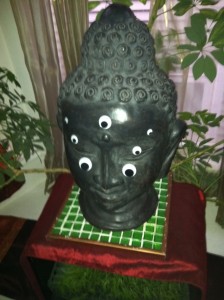It’s a very busy time for me right now. I just got back from Portland Comic Con, Gamestorm is coming up, and I’ve got a lot of irons in the fire. I’m itching to start talking about Codex, and in the future Codex discussions will be interspersed with Dragonmarks. However, I’ve still got a few things I want to finish up first, so for this week, it’s more Eberron questions. As always, all answers are my personal opinion and may contradict canon sources!
This week we have a few different topics: warforged, paladins of Aerenal, Overlords of the Age of Demons, teleportation, and more. First up: WARFORGED AND HOUSE CANNITH.
How do you see Warforged evolving and where do you see their race going in the future?
First off, I’ll point out that warforged are capable of physically evolving. The Reforged and Warforged Juggernaut prestige classes both involve a physical transformation; the warforged juggernaut actually grows heavier armor and spikes. Warforged are fundamentally magical entities, and they are living constructs; there’s more to this than just being sentient. So I think it’s quite possible that if you jumped forward a hundred years, you’d find a vast range of unique warforged who have adapted to different environments and circumstances.
With that said, the greatest obstacle in their evolution as a race and their future is their inability to procreate. The Lord of Blades is trying to address this by seizing control of a creation forge and finding a way to make it work. In The Dreaming Dark novels, Lei’s parents explore a different solution to the issue of warforged procreation. Following the previous path, perhaps some warforged could evolve the ability to procreate. However, if any of these come to pass, how will the rest of the world react? The threat of the warforged is limited because of their numbers. If the Lord of Blades is found to be producing new warforged, will nations or houses band together to stop him?
If Cannith permanently split into West/East/South, can you see them becoming “Corporations”, or what would happen?
If they permanently split, I think they would logically seek to become separate houses individually recognized by the Twelve; after all, Thuranni and Phiarlan have paved the way for this. The only question I see is if one of them would instead choose to ally directly with a nation as opposed to becoming a smaller house… if Jorlanna would ally with Aundair, for example. There’s also the question if any would keep the Cannith name. In the case of Phiarlan, the larger house kept the original name, and I suspect the same would hold true here.
Next up: TELEPORTATION AND HOUSE ORIEN.
House Orien controls teleportation in Khorvaire, but it is unclear what you are actually paying for. The Campaign setting says that teleportation is 10 gp per mile. But they left the service description out of the book. From reading the rest of the Eberron Campaign Setting (ECS) and having a little knowledge about some of the novels I believe the mode of transportation is a teleportation circle. Is that true?
It depends what you’re playing, and exposes the challenge of multisystem design.
Eberron was designed for the third edition of Dungeons & Dragons. The premise was that magic of up to third level was fairly well integrated into society. Higher-level magic – such as teleportation – was not. It’s possible to pay Orien for teleportation, but what you are paying for is to have an heir with the Siberys Mark of Passage transport you using the once-per-day power of his mark. Looking to random locations where I know this is discussed, it’s called out on page 11 of Secrets of Xen’drik—which includes the percentage chance of finding such an heir on any given day in Khorvaire’s largest cities—and page 67 of City of Stormreach, which suggests that a teleporter comes to Stormreach about once every three days. So it’s a service that exists, but it’s not reliable; per SoX you could be waiting in Korth ten days before a teleporter shows up. With this in mind, I’ll note that the idea of charging “by the mile” makes no sense at all. It doesn’t make that much difference to the teleporter whether you’re going five miles or a thousand, and you’re using his daily charge either way; so the idea that you could pay ten gp to teleport ten miles is just silly. Any sort of teleportation is going to cost thousands. It’s a service that only the very wealthy can afford, and even they can’t always get it.
By contrast, Secrets of Sarlona reveals that Riedra is a nation that does have institutionalized teleportation circles and goes into detail about them. This was always intended to be a concrete difference between Riedra and Khorvaire, a reflection of the supernatural power of the Inspired and a contributing factor to the unity of their culture.
Then Fourth Edition comes along.
In 4E, Linked Portal is a level 8 ritual that allows the user to access a network of circles, described in the ritual as being at “most major temples, important wizards’ guilds, and large cities.” We address this on page 45 of the 4E Eberron Campaign Guide, stating that House Orien maintains Khorvaire’s network of linked portals and heirs perform the ritual for travelers. I show this system at work in The Fading Dream.
With that said, I don’t particularly LIKE this system. It’s too institutional and advanced for 998 YK Khorvaire as presented in Eberron, and makes airships and lightning rail travel largely obsolete. As such, unless I’m running a 4E campaign, I would ignore it completely and keep teleportation as a rare and expensive service.
If it is a circle does it function just like the teleportation circle spell or did you have a few tweaks you were planning on? If they use circles, where are they? Which leads me to another question – how frequent would the guild houses be; every outpost or town? If that is true, how are they operated? The way I understand the teleportation circle spell is that it can teleport you anywhere. From reading the ECS I get the impression that the House of Orien uses a connected network of circles to jump from point to point. Which is more correct?
By default 3.5 rules, there is no circle service at all: you hitch a ride with an individual teleporter with a Siberys mark. By 4E rules, it’s not using teleportation circle, it’s using linked portal. As such it only provides direct transportation between portals. The ECG says “House Orien maintains an extensive network of permanent teleportation circles in cities throughout the Five Nations. Outside the Five Nations, circles are less widespread, limited to the larger cities and national capitals.”
Again, while it’s there to accommodate 4E rules, this system doesn’t fit my personal vision of Eberron in 998 YK. It makes travel to remote locations too quick and casual; I’d rather that a trip to Stormreach be significant as opposed to a quick stop down at the Orien enclave.
Who operates the circle? Is it a high level mage or is any house member capable of operating them? The last teleport question, how does the house member know where the traveler wants to go? If I understand the spell correctly the caster can travel anywhere as long as they are familiar with the location.
If we’re talking circles, then we’re talking 4E’s linked portals. Which means you tell the house member the destination city and they take you to the portal. It’s not as flexible as a 3.5 teleportation circle spell.
Next topic: PALADINS AND THE DEATHLESS.
One of the tasks that was trusted to me by the GM was creating a Paladin from Aerenal. We felt that some of the standard Paladin abilities just didn’t fit. So I changed a couple of things. We dropped turn undead. We felt the undying and undead were too closely related for the purpose of what the ability did. So we turned to Pathfinder and borrowed the Channel Positive Energy ability. It allows the Paladin to heal injuries or deal damage to negative energy undead. We both thought that fit the flavor of Aerenal much better.
While you didn’t ask this as a question, allow me to address it. if this is something you’re doing for ALL paladins in order to give paladins a more distinct role from clerics—which I’d argue is the goal of the Pathfinder shift—bravo. However, if you’re saying that you’d specifically change the ability for paladins of the Undying Court because they work closely with the Deathless, I have to disagree. The Deathguard—which most of the paladins of the Undying Court are part of—is specifically charged with seeking out and destroying negative energy undead, and Turn Undead is obviously a potent tool in that war. As for the deathless, it allows them to “rebuke” deathless. But what does this actually MEAN? When you rebuke undead, they are either awed (and leave you alone) or controlled. That’s the mechanical effect, but what’s the in-game explanation? To me, it’s a matter of the deathless voluntarily recognizing and respecting the authority of the paladin. It is no different from a police officer flashing his badge and demanding that people either stand aside (awed), or commandeering civilian resources to deal with a crime (controlled). If you portray the deathless as fighting against it and being forced to comply against its will, it seems highly inappropriate… so don’t. Portray the deathless as choosing to alter its behavior of its own free will because of the paladin/cleric’s display of divine authority. The Paladin is the agent of the entire Undying Court; if the paladin is high enough level, that gives them enough clout to ask a favor of an individual deathless.
With that said, if the power is abused for trivial purposes, it is just like a cop commandeering your car and then using it to buy donuts. He could DO it, but if you report it to his superiors, he’ll get in trouble for doing it. A paladin who abuses his authority—rebuking without good reason—should suffer the same sort of disciplinary action from the mortal authorities of the Court.
And bear in mind, any positively aligned cleric/paladin can rebuke deathless. A paladin of the Silver Flame or Path of Light can do it. If you follow my interpretation, this is because the Deathless recognizes them as agents of a benevolent divine force and chooses to work with them; it’s interagency cooperation in the name of greater good. If you take a forced-into-slavery approach and take the power away from Aereni paladins, you have the strange situation of Kalashtar paladins being able to command deathless when the Deathguard can’t.
Where I am struggling though is the spells. With the background of all the arcana in Aerenal should the Aerenal paladin have access to arcane magic instead of divine?
A lot of people focus on Aerenal’s arcane achievements. In 4E people sometimes ask if Aereni elves should have a bonus to Intelligence instead of Wisdom. But bear in mind that while Aerenal is relatively advanced in matters of arcane magic, its greatest achievement by far is divine. Aerenal has created a god. The Undying Court is the only active, sentient force in the setting that wields full divine power. It’s equivalent to the Silver Flame, but you can actually go and talk to the beings that are a part of it. And an Aereni paladin is a direct agent of than conscious, active divine force. Frankly, no one has a better justification for wielding divine magic than an Aereni paladin, called by the Court to act as its hand in the world. If you want to reflect the tradition of the arcane, multiclass as wizard. You could even use something like the Silver Pyromancer PrC from the Silver Flame. But I see no reason to take away an Aereni paladin’s divine spellcasting ability; if anything, I’d expand it.
Turning from the divine to the demonic, it’s time for OVERLORDS AND THE UNDEAD.
Is there a list of all the rajah already published somewhere? With the rajah’s theme, location and where to find the full writeup?
I’ve never done it. However, Lord Gore at the WotC forums put together this list, which may be the most comprehensive around.
- Bel Shalor the Shadow in the Flame (Tamor Hills, Khorvaire) ECG page 29
- Dral Khatuur the Heart of Winter (Frostfell) female overlord Druid 25/Sorcerer 15/Frost MageFb 10 Death, ColdFb, WinterFb unpublished
- Eldrantulku the Oathbreaker (unknown) NE male overlord rogue 15/sorcerer 15/mindbenderCAr 10 CorruptionBoVD, Trickery Dr 337 pages 63, 69-70
- Katashka the Gatekeeper (Lair of the Keeper, Khorvaire) LE male overlord cleric 8/wizard 8/true necromancerLM 14 Deathbound, UndeathECS DoE page 36, Dr 337 page 70, ECG page 30
- Rak Tulkhesh the Rage of War (Khorvaire) NE male overlord fighter 15/blackguard 10/cleric 15 Destruction, War Dr 337 pages 65, 70; ECG page 31
- Ran Iishiv the Unmaker (Korrandar, Sarlona) SoS page 12
- Sakinnirot the Scar that Abides (Stormreach, Xen’drik) CoS page 156
- Shudra the Fleshrender (Mel-Aqat, Xen’drik) PGtE page 155, TFoW page 127
- Sul Khatesh the Keeper of Secrets (Arcanix, Khorvaire) LE female overlord wizard 36/archmage 4 Knowledge, Magic CoS 89, Dr 337 pages 60, 68; ECG page 31
- Tiamat the Daughter of Khyber (Pit of Five Sorrows, Argonnessen) DoE page 9
- Tul Oreshka the Truth in the Darkness (unknown) CE female overlord bard 20/wizard 10/loremaster 10 Madness, ShadowECS Dr 337 pages 64, 70
- Unnamed (Krertok Peninsula, Sarlona) SoS page 12
- Unnamed (Sustrai Mor, Sarlona) SoS page 91
- Unnamed (Tempest’s Isle, Lhazaar Principalities) PGtE page 99 possibly a rajah
- Yad-Raghesh (The Vale of the Fallen Rajah, Argonnessen) colossal two-headed overlord DoE page 50 “dead”
I believe that Sul Khatesh is the only one that’s received a complete 3.5 writeup, in Dragon 337. I’ll also note that I prefer the term Overlord. “Rajah” tends to get subsumed into “rakshasa rajah”—and while the Overlords rule the rakshasa, they are not themselves rakshasa.
Is there any connection between Katashka the Gatekeeper and other prominent undead-themed entities (eg Vol and her followers).
Not according to canon. However, you could always decide that Katashka is connected to all negatively empowered undead, whether they know it or not… and that Vol, Kaius, and other influential undead are all secretly pawns in the Overlord’s plans. This certainly seems like a fine approach for starting with the Emerald Claw as a heroic tier threat, moving to Vol herself in paragon, and then bringing Katashka in as the true epic threat. For those wanting to know a little more about Katashka, check out Dragon 337 or this Eberron Expanded article.
I just read the original ECS and it gave the impression that the Blood of Vol worship/idolize undead, when I recall that this has been clarified as not true in later books; what is going on with the Blood of Vol?
I’m not sure exactly what the question is here. You are absolutely correct that I consider the depiction of the Blood of Vol in the original ECS to be flawed. They don’t idolize undead; however, many or their martyrs and champions ARE undead, which can cause others to think this. Later books give a more rounded view of the Seekers. Here’s a quick description I wrote a little while ago…
The Blood of Vol is based on the question “What just god would allow suffering and death?” – with the conclusion “None, so the gods must be our enemies.” It’s tied to the fact that the people of Eberron KNOW what the afterlife is like, and it’s not pretty. The Elven religions seek to avoid going to Dolurrh; the Silver Flame believes its people join with the Flame; and the Vassals say “Well, we go to Dolurrh, but you just don’t understand what it really is.” The Seekers say “You’re kidding yourself. Dolurrh is extinction. But we have the divine spark within us. We can become gods – and even if we can’t, we will spit in the face of death.”
What I really need to do is to get all these Q&As organized into a master list by subject. Until then, take a look at this Q&A – there’s a lot about the BoV there.
And finally, a little RANDOM STUFF.
I’m sorry if this has been asked before, but you said the scale of Khorvaire was incorrect. How so?
I feel that the Five Nations should be on the scale of France and England; by the original maps, they’re on the same scale as Russia and China. It’s a question of travel time between nations, the logical impact an army traveling on foot can have, and similar things.
Apart from some druids, are there people that consider magic as dangerous or evil? What if its use did caused the mourning?
If it caused the Mourning, then you might want to listen to the Ashbound and Children of Winter or there might be another Mourning soon. I don’t believe we’ve specifically described any antimagic groups in canon, but I’m sure there are some out there.






